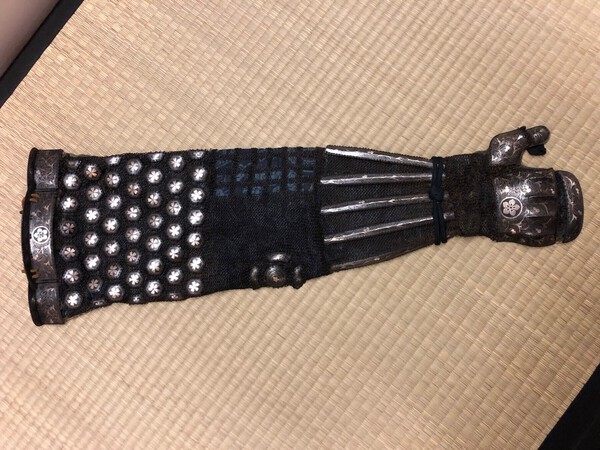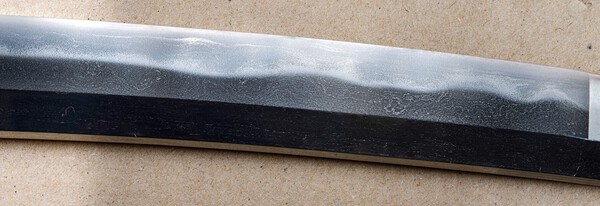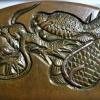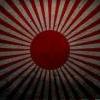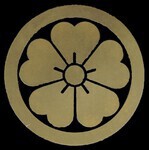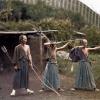Leaderboard
Popular Content
Showing content with the highest reputation on 12/05/2021 in all areas
-
應筒井實需 Tsutsui Minoru no motome ni kotaeru Made by request for Minoru Tsutsui Pronunciation of the year should be Kōki ni sen roppyaku san nen ....4 points
-
These are easily the best reproductions out there in terms of detail, quality of mounts and good blades. The maker is Hanwei.4 points
-
It's Mondonosho Masakiyo. I bought it without papers but obviously I saw the signature... which is btw not the most typical for him, so I was happy it papered - and possibly despite couple of kanji being a bit off... well, he did change the writing somewhat over the years and right before he went to the Shogun, so probably its from this time My take is that there are couple of things here. First there are well defined "gaps" in nie right in the middle of hamon. This is something popularized by Inoue Shinkai and after him a lot of Soshu style works tried to do this. But Shinkai would have dense, Osaka-style jigane. Here the jigane has almost koto feeling, with wide elements, somewhat rough and darkish, with ara nie. We'll see this jigane a lot in shinshinto but with much more ara nie... Its Satsuma. So its a top quality shinto work in Soshu style with Satsuma jigane.... Masakiyo.4 points
-
3 points
-
Bruce the blades themselves are good quality and made for martial art use.3 points
-
Date is hard to see but looks to me like it might be "? thousand ? hundred year" (that is: Koki 2 thousand 6 hundredth year) = 1940.3 points
-
from chinese producers. Frightning. Tsuba $90 (2 x available) sofecoke sword | eBay Stores Hard Times2 points
-
Look at the Ebay site he has sold hundreds of the fake fittings, one more way to ruin a hobby for the new person everyone should look at what they are producing to educate yourself Fred Geyer2 points
-
I think it's good Bruce that these are so expensive. The market would overflown if they cost $2502 points
-
This is an authentic example and the koshirae dates to the Meiji period. Better photos are needed to evaluate the blade, but it almost certainly predates the koshirae and is an older osuriage mumei blade. Early Edo or before.2 points
-
1 point
-
1 point
-
1 point
-
Dear Simon. There was another link to this site where all the descriptions were weird, to say the least. Not to defend the expertise or lack thereof but I wondered if the original was catalogued in French and what we see is the result of a dodgy translation. I could not otherwise account for descriptions that proudly stated tsuba were cast iron , rather like this menpo. All the best.1 point
-
I think you need close ups of both sides of the handle I bet it is glued in1 point
-
Deyanne, Usually the swords with carved bone mounts are low quality items, intended for the late meiji period tourists and export market. However, in rare cases the carving is better quality with fine details and can house good blades. Yours seems to be in the middle somewhere. The carving is good, with some detail. I would still expect the blade to be mediocre, but it has a chance. Sadly many are glued into the mounts. You would need to carefully examine it and see if there is a pen somewhere in the tang. I think start by taking some decent pics of the blade, tip and any visible temper line. Let's see if the blade reveals signs of quality.1 point
-
Deyanne, welcome on board the NMB! What you have there is not a SAMURAI weapon but an item that was mostly made for the early Western tourists who came to Japan at the end of the 19th century. It is not a scrimshaw work but bone (in some cases ivory) carving, and it is well made. These purely decorative items mostly contain rather worthless blades, but there are exceptions. Your pictures do not show if there is a pin (= MEKUGI) in the handle to secure the blade. In case you find one, please press it out from the side where it appears bigger. The blade should then come loose. Please do not touch it with your bare fingers, as this will cause rust. If there is nothing of that kind, the blade might be glued in, which would be a bad idea....In this case, there is not much hope that it could be a traditionally forged blade. Depending on where you live in the States, there might be an expert NMB member near you who will be happy to have a closer look at it.1 point
-
Second weekend's offerings - Item no. 170 Iron Tsuba with silver and brass inlays 8.47 cm x 8.00 cm x 0.55 cm up to 1.09 cm on Rim Big Tsuba with Nobuie style Kanji , Hitsu Ana as Daikon? Heavy forging to Rim , Signed but indistinct , deep brown patina. Item No. 171 Iron Tsuba 7.63 cm x 7.33 cm x 0.75 cm Iron Tsuba very solidly built, very dark , almost black patina . Sado school ?1 point
-
Tough one, being honest im very unfamiliar with the name and would only have got this if id owned or looked into buying one of his swords. Was surprised when you said Shinto, as you mention the jigane looks earlier. Was hoping the shot at Inoue Shinkai was one of those swords that dont quite fit, like when you come across top Hizen smith blades that are not typical Konuka hada. Again, the amount of big names and Ko-itame that was around on searches for swords of this period stood out like a sore thumb Good to learn about this particular smith, interesting and fine blade. Cheers1 point
-
1 point
-
The "Kinsuji" are the giveaway - Inoue Shinkai would come to mind but he never made this shape. Very nice find, Kirill. I hope you'll bring it to our "Satsuma" meeting next year... -t1 point
-
1 point
-
The hitsu shape is popular it seems, this one is plain Iron with no added decoration. https://www.jauce.com/auction/c768631453 There is an air of great age about it though.1 point
-
Thanks for the reply, Stephen. It seems Pablo has relocated to the UK. Touken Matsumoto also used to do a sword show in Okinawa, but I think the last one was in 2016. On his website it states that there are no sword shops in Okinawa, hence why he organised the shows (a fresh market). There’s a seller on Bookoo with quite a few nihonto from Nakagami, so perhaps I’ll get in contact them. Cheers!1 point
-
Jean "you cannot add material to the item", yes, but you can add surface smoothness, 'patina', and TLC.1 point
-
I really need to do a lengthy post here with my most current thoughts on black Type 95 saya set out. I'll get to it soon!1 point
-
I love seeing mis-stamped 95s. I have quite a collection of photos of mistakes made with stamps, whether incorrect orders, orientation, location or double strikes. Just that unique and human element to sword production.1 point
-
1 point
-
So how I got the tsuka off in only 4 hours.... The nakago was very rusty and I think there was a small wooden shim or broken piece of wood in there too. It really wouldn't budge. My fingers ache now. I used the table method for a while and after an hour managed to get a few mm clearance. I wrapped the tsuba In the towel and used a rubber mallet to tap it over and over while using rubber gloves to hold the tsuka. This got me enough to wedge a fork between the Seppa collar and the tsuba. I wrapped.the fork in electrical tape so as not to damage any metal and used it to apply a lever force to the tsuka as gently as I could and did this all round this took a while but I couldn't see light in the mekugi ana anymore. With a combination of this and running a little choji oil down between the fittings I could hear it moving slightly. I had to do this for a while. Even at the end it required a fair bit of force to get off. Hope you guys enjoyed the adventure!1 point
-
Michael, I also can’t whether speak nor read or write Japanese and the little electronic helpers are not necessarily reliable! Anyway, the title of the big book is “日本家紋総鑑” (literally, Japanese family crest comprehensive book). It’s quite rare and very expensive! But be aware, it is not dealing only with medieval heraldry!!1 point
-
Hi Guys, I've been out of action for a while and missed this post. But here is one of mine, a tsuba signed Efu ju Namitoshi. Signature looks with the ones shown above and design of bamboo seems to have been a favourite of Namitoshi. This tsuba came from the Peter Newall collection an antique dealer and artist whose collection lay undisturbed in a loft for 30 years after his death (luckily it was not damp)., Best regards, John1 point
-
Hi Michael, besides the well known Chappelear I manly using the following books: A paperback version of this (only in German) The Shogun's eighty thousend guards (only in Japanese) and this big boy here, with over 1300 pages (only in Japanese) Both Japanese books are cumbersome to navigate if you're not familiar with the language. That costs a lot more time in what is already a difficult subject....1 point
-
Splendid koté. That Mon is most famous for Akéchi Mitsuhidé, who killed Oda Nobunaga.1 point
-
It is a place name in Omi province. Ref. Ōmi Province - Wikipedia1 point
-
Blade probably added to koshiare, lower hole has been recently drilled or the Burr was filed1 point
-
This is a torikubi (no) tachi. Here is an article on torikubi (no) tachi that Markus Sesko shared online: https://www.militaria.co.za/nmb/applications/core/interface/file/attachment.php?id=74508 Please do not place the bare blade or its koshirae on the ground. This will damage the polish, lacquer, soft metal fittings, etc Best regards, Ray1 point
-
1 point
-
Source: Allan, Francis C., and Carl J. Goddard. The Japanese Naval Special Type 99 Rifles and Carbines. Anchorage, Alaska: AK Enterprises, 1999. Page 36. @Shamsy & @Stegel I thought you two might enjoy this passage about paint in regards to naval manufactured rifles. I know Stegel has mentioned the use of both gloss and matte black paint and I found it interesting that both were noted on the rifles. Hope this helps in your scholarly endeavors.1 point
-
There is also the possibility that it might have travelled and acquired the decoration in the process. Hence possibly a Shoami plate with added nunome zogan. Have a look here for an example of this argument. https://www.facebook.com/564035753684007/photos/a.564041667016749/2068458839908350/ All the best.1 point
-
Possibly Hizen or Shoami I have a Shoami tsuba with the same cutouts (hitsana) but not nunome zogan1 point
-
Dear Yves. The Namban flavour to the outline of the seppa dai and the nunome zogan might lead to Hizen, at least for the decoration. All the best.1 point
-
Considering most gimei were done at the time of manufacture, and not just for devious purposes...I maintain that unless necessary, the current state is the original state. And therefore removing the mei, and manipulating the tang and patina makes it less original and more altered. But at the end of the day, it's your decision and money.1 point
-
Whilst the sword is probably gimei ,I think , it would be foolish to remove the mei before you send it to shinsa . There are twelve generations of Yasutsugu so you never know what a Shinsa panel might say . I also think it would be equally foolish to get this repolished . The current polish looks good and a new polish would only be warranted if the mei was genuine . You will never get your polish money back on an unsigned shinto piece where some wally has messed around with both sides of the nakago. Also , unless you have this polished by a Japanese trained polisher then the chances are high that the polish you get back will be worse than what is there now. You have a nice piece take your own advice and leave it alone.. Ian Brooks1 point
-
Eric - you raise the question of preservation vs restoration and as Brian above has pointed out there is no need to remove the signature unless youre in for full restoration. Jimmy Hayashi in San Francisco is a fully trained polisher and Brian Tschernega, on the west coast, has the skills to do what you ask. However I think if you want to get it restored best to make the full investment and send to Japan. -t1 point
-
Thanks for the feedback all. I appreciate you all taking the time to provide your input. I guess my suspicions were correct after all, unfortunately. Even though its a gimei, I'm still stoked that I now own a beautiful looking sword. I never thought I would inherit anything cool like this from my grandparents. Gimei and all, it is still something I will proudly pass down. Thanks again!1 point
-
Does anyone care to explain this one to me? https://www.sothebys.com/en/buy/auction/2021/the-samurai-Japanese-arms-and-armour-2/a-katana-signed-tenmangu-ni-oite-rokujunichi-kyoku 126,000 GBP??? Umm, I don't get it?1 point
-
I can’t comment on the habaki in question, but might be able to explain how gold habaki are described/marketed in Japan. There are basically two types: 1. Kinmuku 金無垢, i.e. solid gold. In a strict sense this means junkin 純金, 24 ct, but often 18 ct is used (at least I was told so). 2. Kinkise 金着; this is often called "gold plating", but actually means "gold application", usually in the form of gold foil. The correct term for gold plating is kinmekki 金めっき. The base material for kinkise-habaki is copper.1 point
-
That is an interesting thread. Can anyone point me the direction of finding out more about habaki schools? What about during WW2? Was there a particular style / school that was used for by the military?1 point
-
Greetings sword friends, I am reporting a sad, serious state of affairs here related to our German friend Guido Schiller. I have just spoken with Guido's wife, Minako, and she said Guido has been in intensive care in Germany since some time in October. The stroke has robbed him of speech and mobility. At this point, the physicians have not indicated prognosis, other than it is going to take time. Some friends had contacted me because their mail to Guido went unanswered and now we know why. Please send positive cosmic energy to Guido. NMB still needs his dry and clever wit! Best, Robert Hughes0 points
-
0 points


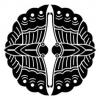




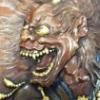

.thumb.jpg.741ed7ea21e8240f70ff93c4e50b8bf2.jpg)
